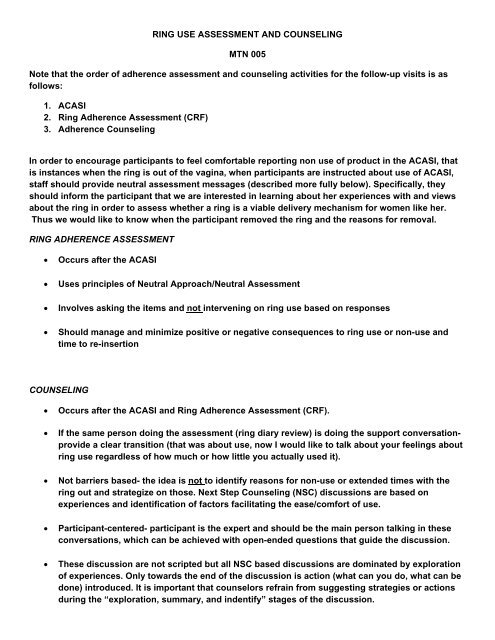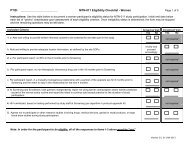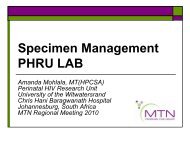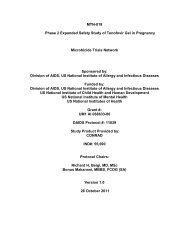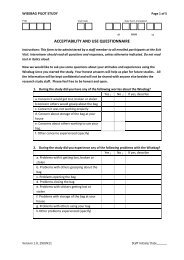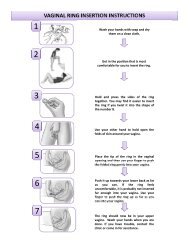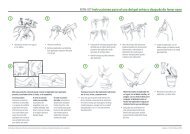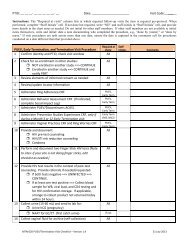RING USE ASSESSMENT AND COUNSELING MTN 005 Note that ...
RING USE ASSESSMENT AND COUNSELING MTN 005 Note that ...
RING USE ASSESSMENT AND COUNSELING MTN 005 Note that ...
You also want an ePaper? Increase the reach of your titles
YUMPU automatically turns print PDFs into web optimized ePapers that Google loves.
Goals are to engage the participant in an open discussion about experiences with and feelingstowards the ring — not to make participants adhere — and empower participants to feel <strong>that</strong>ring use is a choice and decision <strong>that</strong> they are free to make.FULL TEAMAvoid “messaging” [“you need to…”, “don’t forget to….”, “be sure to…” on need for adherence(allow assessor to collect ring use rates and counselor to work with participants on facilitatorsand challenges)
SHORT SHEET ON NEUTRAL <strong>ASSESSMENT</strong>Neutral Approach: The basic premise for neutral assessment is the recognition <strong>that</strong> reporting on product useor returning of product is a behavior <strong>that</strong> goes beyond the simple reporting of events, even when you can fullyrecall or provide the “data”. Against a backdrop of a “standard of care” in many clinical trials where perfectproduct use is framed as largely expected and intensively messaged on, the realization was made <strong>that</strong> someparticipants felt <strong>that</strong> reporting non-adherence or returning of product <strong>that</strong> suggested they had not beenperfectly adherent was too uncomfortable to be worthwhile. Further, with multiple people messaging onadherence, some participants felt <strong>that</strong> they were valuable to the study only to the extent <strong>that</strong> product was usedperfectly. “Neutral Approach” was coined to reflect <strong>that</strong> when a trial is interested in assessing and monitoring abehavior, the best approach is to be as neutral as possible about the behavior.Applied to studies where product use is part of the primary aims or contribute to secondary aims, it issuggested <strong>that</strong> we can help to promote an atmosphere where participants would feel comfortable reporting onthe target behavior regardless of adoption of it by minimizing both positive reinforcement for reporting highrates of product use and negative consequences for reporting low rates of product use. This is a team-wideapproach, where adherence is assessed on ACASI, product count, or interview with no immediate or delayedconsequence to rates reported (e.g., no additional procedures when adherence is low, excessive probing,negative feedback from staff or clinician, so on). That means <strong>that</strong> assessment is completely separate fromcounseling. If someone reports non-adherence we thank them and move to the next question. Messaging onproduct use is also recommended to be restricted; rates of use are gathered by either collecting the productand asking a minimal set of questions for product accountability issues (e.g. Did you forget any at home?)and/or implementing the procedures for collecting data on interview or CRF forms.On interview, the participant is informed <strong>that</strong> this part of the visit is all about collecting detailed informationabout product use. A permission statement is typically provided to assure participants <strong>that</strong> the interviewer isnot judging them and wants to know what really happened rather than focusing on high or low rates ofadherence. Participants are informed of the exact procedures (I will ask you X and write down Y) and thelimitations of the conversation. (Because this is a data collection interview, I will stick with the questions forthis- we can talk about things in more detail later if you want, but for the next few minutes, I am going to focuson collecting data about the ring, when it may have come out, and when it was reinserted). Incorporating someMotivational Interviewing strategies, some sites also seek permission- Is <strong>that</strong> OK with you?- before proceeding.The tempo of the interview-based data collection discussion sticks to the items and responses- not in a cold ordetached manner but in a manner <strong>that</strong> does not convey “good” when ring use or re-insertion in a timely fashionis reported and does not convey <strong>that</strong> the ring coming out was or long delays in getting it back in were “bad”.Where participants can be strongly reinforced is for coming in today, sticking with the project, and openlydiscussion things. Reinforcement on ring use is not targeted or provided.Once the interview is completed, the participant is thanked and the staff then transitions to a risk use supportdiscussion (section I below) or the interview is closed if the participant is moving on to receive adherencesupport from someone else (section II below).
SHORT SHEET ON <strong>RING</strong> <strong>USE</strong> SUPPORT DISCUSSIONS (STREAMLINED STEPS)I TRANSITIONING FROM <strong>ASSESSMENT</strong> TO <strong>RING</strong> <strong>USE</strong> SUPPORT SAME STAFFIf the participant is remaining with the same person for the adherence support discussion, the staff membershould transition- Thank you for all <strong>that</strong> information. I would like to switch gears now. That was all about data. Iwas wondering if I could take just a few more minutes of your time to check in with you about what it has beenlike for you more generally with the ring. I know we just talked about when it was in and when it was not andwhy, but what I really want to know if what it was like for you over the last month. OK?- {move to step 1}II TRANSITIONING FROM <strong>ASSESSMENT</strong> TO <strong>RING</strong> <strong>USE</strong> SUPPORT DIFFERENT STAFFIf the participant is coming to you for counseling already having completed the assessment with another teammember, transition into discussion of ring use/experiences- I know you have already talked quite a bit todayabout the ring, but I was hoping you might take just a couple of more minutes to share your experiences withthe ring in terms of how it fits or does fit into your life right now. You have done plenty of reporting on when itwas in and when it was out. I would like to discuss something completely different- Your feelings about havingthe ring, no matter if or how long it was in- just your feelings about it. Does <strong>that</strong> sound OK?- {move to step 1}BASIC PIECES IN THE PARTICIPANT CENTERED DISCUSSION (based on Next Step Counseling)[alternatively, the full VASP approach applied to <strong>MTN</strong> <strong>005</strong> <strong>that</strong> follows on page 4 could be used]. The spirit ofthis conversation is open, non-interrogative, and casual but also requires <strong>that</strong> paper and checklists be putaside and the counselor actively attend to the participant.STEP 1: Explore First ask: What made it feel like this ring would fit well into your life, if anything? {Listen}.Second ask: What kinds of things or situations came up where the ring was not such a good match to youand your life? {Listen}STEP 2: Summarize- If the participant has alluded to these factors in the assessment interview, provide asummary and ask if there are other factors? Summarize what seems to make the ring a good fit (easy to keepin) and a not so good fit (challenging to have it in or re-insert it).STEP 3: Identify- if something could help to make it easier to use/re-insert-- For participants noting any levelof difficulty or challenge, ask if there is anything she could imagine or think of <strong>that</strong> might make it easier or morecomfortable for her to use the ring (keep it in or re-insert it).STEP 4: Strategize- If something is identified, discuss first how SHE could see <strong>that</strong> happening and if shecannot offer something <strong>that</strong> would help, offer solutions framed as strategies other participants have foundhelpful (avoid saying this is your idea or suggestion as <strong>that</strong> can creating problems in future interactions).STEP 5: Close the conversation by thanking the participant and reminding her of any product use instructions<strong>that</strong> appear important and letting her know you will check in again next visit.Be sure to document in your chart notes the basics of the conversation (facilitators, challenges, things <strong>that</strong>would make it easier/more comfortable, and strategies) so <strong>that</strong> next visit you can appropriately follow-up.EXAMPLES:Thank you for coming in today. Sorry <strong>that</strong> this visit is taking so long. I know you have been asked a lot aboutthe ring today, but I was hoping we could spend just a few more minutes talking about your experiences with itnotwhether or not you had it in for however long, but more your feelings about how this ring fits or doesn’t fitwith your life- does <strong>that</strong> sound OK?...Thank you. Can you tell me what it has been like for you over the last
month- specifically, the kinds of things <strong>that</strong> have made the ring feel easy to use or fit well into your life? {Listen}What are the things or situations <strong>that</strong> made the ring feel like a poor fit with your life- times when it felt differentto have or use? {Listen} So it sounds like there are times when you don’t notice it at all and <strong>that</strong> makes it prettyeasy to incorporate into your life and there are also times when it feels awkward, like something not natural isinserted inside you and <strong>that</strong> made it kind of uncomfortable. And there were some times when re-inserting it feltlike you just couldn’t get it right. Does <strong>that</strong> sound right to you? ….Is there anything <strong>that</strong> could make the ring feeleasy to use- something <strong>that</strong> could comfortably fit into your daily life? …So if you felt better able to re-insert itwould make it easier for you. Do you have some ideas for how <strong>that</strong> could happen?...Yes, I can definitely cover<strong>that</strong> with you again. Let’s talk about <strong>that</strong> for a minute…. Thank you for taking the time to share yourexperiences with me. I’ll check in with you again next time you are in.Thank you for providing all <strong>that</strong> information. I know we just went over in great detail your use of the ring, but Iwould like to switch gears completely for a few minutes. We touched on reasons why the ring came out, but wedid not spend much time talking about your feelings about the ring and its match to your life, or mismatch. Canwe take just a couple more minutes to touch on <strong>that</strong>? How you are experiencing the ring is so important. youhave been asked a lot about the ring today, but I was hoping we could spend just a few more minutes talkingabout your experiences with it- not whether or not you had it in for however long, but more your feelings abouthow this ring fits or doesn’t fit with your life- does <strong>that</strong> sound OK?...Thank you. Can you tell me what it hasbeen like for you over the last month- specifically, the kinds of things <strong>that</strong> have made the ring feel easy to useor fit well into your life? {Listen} What are the things or situations <strong>that</strong> made the ring feel like a poor fit with yourlife- times when it felt different to have or use? {Listen} So it sounds like there are times when you don’t noticeit at all and <strong>that</strong> makes it pretty easy to incorporate into your life and there are also times when it feelsawkward, like something not natural is inserted inside you and <strong>that</strong> made it kind of uncomfortable. And therewere some times when re-inserting it felt like you just couldn’t get it right. Does <strong>that</strong> sound right to you? ….Isthere anything <strong>that</strong> could make the ring feel easy to use- something <strong>that</strong> could comfortably fit into your dailylife? …So if you felt better able to re-insert it would make it easier for you. Do you have some ideas for how<strong>that</strong> could happen?...Yes, I can definitely cover <strong>that</strong> with you again. Let’s talk about <strong>that</strong> for a minute…. Thankyou for taking the time to share your experiences with me. I’ll check in with you again next time you are in.Again, thank you for all you are doing today. I wanted to take just a few more minutes to talk with you aboutyou experiences with the ring- how it has been for you using or trying to use it. OK? Are there times when thering felt or feels like a good match for you and your life- like it is really easy to use? {Listen} Are there timeswhen it felt like a not-so-good match for you or things going on in your life- when it was or is hard to use?{Listen} …So, it sounds like using the ring feels pretty easy to do for you- you mentioned you don’t even noticeit really, and there are not really times when it feels difficult to use. Is there anything we can talk about today<strong>that</strong> might be helpful in continuing to make the ring feel easy or manageable to use over the next month?...OK.Well, thank you for sharing so openly with me. I’ll check in with you again at your next visit.
EXAMPLES BY STEPSTEP 1: ExploreWhat have your experiences been with the ring over the last month? What are things <strong>that</strong> seem to havemade the ring easy to use? What are some things <strong>that</strong> made it difficult for you to use? {or re-insert}Could you please share with me…what is it about the ring or its fit with your daily life <strong>that</strong> made it feellike a good match? What are some things <strong>that</strong> made it feel like it was not such a great match?I am wondering if you could share with me your feelings about the ring, and using or not using it. Whenyou think about the last month, were there times or situations when having the ring or re-inserting it feltpretty easy? What were the times or situations <strong>that</strong> made it more difficult to use or re-insert?I know you said earlier <strong>that</strong> you had the ring in the whole time, but I was hoping we could talk a fewminutes about what <strong>that</strong> experience was like for you. Can you tell me what made it easy to use or keepin? Can you tell me, what made it more challenging- even though you kept it in, were there times when<strong>that</strong> was uncomfortable or more difficult to do?STEP 2: SummarizeIf I am hearing you right, you are saying ….. makes it feel easy and ….is challenging. Is <strong>that</strong> right?So, some things <strong>that</strong> make it easy to use are …. And things <strong>that</strong> make it harder to use or re-insertare…. Does <strong>that</strong> sound right to you?So you feel <strong>that</strong> using the ring is really easy and there is really nothing you can think of <strong>that</strong> wouldmake it easier to use. Is <strong>that</strong> about right?STEP 3: IdentifyWhat would help to make it easier to manage using the ring?What would need to be different for using the ring to feel more manageable?What would need to happen for re-inserting the ring to feel like something <strong>that</strong> was just a little easier todo?STEP 4: StrategizeHow could you see <strong>that</strong> happening?Do you have some ideas about how <strong>that</strong> could happen?Can I share some strategies I have heard from other participants <strong>that</strong> might help with <strong>that</strong>?STEP 5: CloseSo it sounds like trying XXX may help to make using the ring as easy as possible for you. I’ll check inwith you next time you come in about <strong>that</strong>. Thank you for talking so openly with me.Right now you are feeling like the ring is really easy and manageable to use, and <strong>that</strong> you feel prettywell set on continuing with the ring over the next month. I’ll check in with you again next time you comein. Thank you for taking this time to share with me what your experiences have been.
ALL 8 STEPSAdherence Counseling Manual: Proposal for <strong>MTN</strong> <strong>005</strong>This proposed adherence counseling manual for <strong>MTN</strong> <strong>005</strong> was adapted from the VOICE AdherenceStrengthening Program, recently developed for the VOICE trial and based on Next Step Counseling and otherparticipant centered approaches for behavior change. The spirit in which the counseling is conducted and themanner in which adherence is understood may represent a different approach for some counselors. The goalof this counseling approach is to create a supportive environment where participants can share theirexperience with the ring while recognizing <strong>that</strong> product use is ultimately a choice. There are 8 steps involvedin the discussion about experiences with the study ring, which are described in this guide. The methodencourages a client-centered approach, the use of open-ended questions, and the importance of buildingrapport with the participant. Adequate documentation and the review of action plans from previous sessionsare also important aspects, to ensure continuity throughout the duration of a participant’s time in the study.This method eliminates or modifies several aspects of the traditional counseling approach, which we believemay undermine the likelihood of participants’ reporting honestly about adherence. The differences betweentraditional counseling and the proposed counseling strategy are outlined in the table below.Key Revisions to Adherence Counseling ApproachTraditional ApproachAsks the participant how often the ring was outand how long it was out and then basescounseling on reported level of adherence.Adherence plan/strategies based onovercoming barriers to product use.Uses reported adherence to determine thefocus of the sessionPositive reinforcement of good adherence.Goals focused on perfect adherence.Proposed ApproachCounseling will focus on participant’sexperiences using the ring, and what makeskeeping the ring inserted easier or harder,regardless of how often the ring came out/howlong the ring was out.Adherence plan/strategies based onaddressing adherence-related needs.All sessions will follow the same 8 steps,regardless of how adherent the participant hasbeen.Maintain a neutral counseling approach.Goals focused on making product usemanageable.GOAL: Create a comfortable environment to talk about experiences with using the ring.CLIMATE: Supportive, nonjudgmental, neutral.METHOD: Exploration of context (experiences, thoughts, beliefs, feelings) to identify needs and promotemovement towards building a context <strong>that</strong> supports ring use.IMPLICIT ASSUMPTION: Participants choose whether, or how much, they keep the ring inserted. We cannotmake them keep the ring inserted all of the time, but can support open frank discussions about it.Steps of Proposed Counseling Strategy1. WELCOME: Greet/Rapport; Thank participant and establish rapport; Check-ina. Goal: Welcome and thank the participant for their contributions to the study (empower). <strong>Note</strong> <strong>that</strong> ifyou’ve already had interactions with this participant during this visit, the goal of Step 1 is torecognize her contributions to today’s visit and in the study more generally.b. Critical Components:
i. Specifically recognize and appreciate the contributions the participant has made (forexample, today’s visit in terms of length, completing measures, procedures or moregenerally in terms of months on study or other ways this individual contributes her time andefforts to this study).ii. Emphasize genuine observations about personal contributions the participant has made/ismaking, and thus empower the participant to see the study as her study, something notpossible without her specific efforts. These efforts are regardless of her actual product use;<strong>that</strong> she is there, has spent time in the waiting room, is speaking with you now, hasundergone study procedures; these are all visible contributions <strong>that</strong> should be recognized.iii. Balance the interaction between the counselor and participant through conversations <strong>that</strong>engage the participant in her contributions to this study (contributions <strong>that</strong> are not linkedspecifically to ring use).c. Examples:i. Before we talk about how you have been doing with the ring I just want to stop and thankyou for coming in today and waiting all this time. You do so much for this study and it wouldnot be at all possible without your contribution. No matter what is going on with the ring thecontribution you make deserves recognition- so, thank you. Thank you for this.ii. You have been here several hours and I want to stop a moment to tell you <strong>that</strong> without yourbeing here ….we would not be able to do this study at all. You make many contributions tothis study, and showing up here today and talking with me is a really important one. Thankyou.iii. We’ve talked about this before, but I think it is worth recognizing every time you comein…you being here today is a great contribution you make to this study. I want to thank youfor this- I see how hard it is to be here so long and the sacrifices you make to do this. Yourefforts are very much recognized and appreciated by all of us.2. FRAME: Explain purpose of discussion; Seek permission to continue discussion.a. Goal: Invite the participant to join the discussion by explaining what you want to talk about, framingit as important, presenting yourself as open, and seeking her permission to continueb. Critical Components:i. Explain what you’re going to talk about and why.ii. Get permission to proceed.c. Examplesi. I would like to take just a few minutes to talk with you about your experiences with the studyring. Would <strong>that</strong> be OK with you?ii. At each visit a counselor will talk with you about your experiences with the study ring. This isbecause we recognize <strong>that</strong> keeping the study ring inserted all of the time can be difficult.Part of this study is to better understand this process. May we spend a few minutes talkingabout what your experiences have been?iii. I know we have spoken together in the past about your experiences with the study ring. I willcheck in with you about this at every visit, because sometimes things change or newsituations come up when it may feel easier or harder to keep the study ring inserted. Theseare all important for the study researchers to learn about- what it is really like to try to usethe study products. Even if things have not changed for you, I am hoping we could justspend a few minutes discussing your experiences with the study ring? Is <strong>that</strong> OK with you?3. EXPLORE: Explore ring experiences (facilitators/challenges); Discuss efforts on strategies fromlast session; Discuss the context (experiences) in which the participant feels it is easiest andhardest to keep the ring inserted (check-in on previous agreement).a. Goal: Establish a shared understanding of the specific context in which this participant experiencesstudy ring use. Elicit factors <strong>that</strong> facilitate ease of keeping the ring inserted first; then factors <strong>that</strong>present challenges to keeping the ring inserted. (<strong>Note</strong>: For month 2 visits and beyond, first check inon how things went with the goal she set at the last visit. Reinforce effort(s) and move conversationto exploration of how things are going now.)b. Critical Components:
i. Elicit (ask about) the context in which she negotiates, manages, or experiences keeping thering inserted.ii. This discussion is independent of the participant’s level of product adherence.iii. Elicit (ask about) facilitators of keeping the ring inserted (times, situations, factors <strong>that</strong>make it feel easy to keep the ring inserted, in a given situation, generally, or over time)iv. Elicit (ask about) challenges to keeping the ring inserted (times, situations, factors <strong>that</strong>make it feel difficult to keep the ring inserted, in a given situation, generally, or over time).v. Establish a conversation about facilitators and challenges regardless of how often the ringwas in/out. Regardless of whether the ring was kept in, one can still reflect on ease anddifficulty.vi. Counselors may need to help participants move away from focusing exclusively on whetherthe ring was in or out; (e.g., Thank you for sharing <strong>that</strong> with me, but I am hoping we can talkabout what your experiences with the study ring have been like, whether you kept it inconsistently or not. Things in your life <strong>that</strong> make it easy and not so easy to keep the ringinserted).vii. The critical aspect of this conversation is to position adherence as1. a choice;2. a behavior <strong>that</strong> is influenced by many things; and3. as needing to fit into the participant’s life (versus needing to work one’s life aroundadherence).The context of one’s life is first and foremost, and adherence to study product is seen asa behavior <strong>that</strong> exists in relation to other things going on in life. Adherence is “situated”within the larger social, cultural, emotional, and situational/circumstantial factors <strong>that</strong>create the participant’s daily life.c. Examplesi. In thinking about the study ring, what have your experiences with keeping the ring insertedbeen? What are the times, situations, or things <strong>that</strong> have made keeping the ring insertedfeel easy, made it fit in your life? What are the times, situations, or things <strong>that</strong> have madeusing the ring feel more difficult, less easy to manage?ii. Think a moment about your experiences with the study ring. Not about whether or not youkept the ring in, but just about what it has been like for you. Can you share with me whatkinds of things, situations, or feelings make using the ring feel like something <strong>that</strong> is easy todo…<strong>that</strong> just works well or fits in your life? What about things or times when it feels likekeeping the ring in is harder to do?d. IS intended to …i. Explore/elicit contextii. Move away from how often the ring was out/iniii. Move towards experiences with using the ringe. IS NOT intended to …i. Identify times when the participant took the ring out/did not reinsert the ringii. Push beyond what the participant is comfortable sharing4. SUMMARIZE: Summarize the context (experiences) in which it is easiest /hardest to keep the ringinserted for this participant.a. Goal: Validate and confirm participant’s experiences by checking in with them about yourunderstanding of facilitating and challenging factors.b. Critical Components:i. Demonstrate active listening and reflection.ii. Promote the feeling of being “heard” on the part of the participant.iii. Provide a summary and elicit participant’s reactions to your summary.c. Examplesi. What I hear you saying is <strong>that</strong> these things {explain} make it easier while these {list} make itharder for you. Does <strong>that</strong> sound right to you?ii. It sounds like you feel <strong>that</strong> your motivation to use the ring comes from wanting to contributeto the study and find new ways for women to protect themselves from HIV. You don’t knowabout times when it feels difficult right now. Does <strong>that</strong> feel like an accurate summary?
iii. If I am hearing you correctly, you feel <strong>that</strong> not a lot has changed since we last explored yourexperiences with the study ring and <strong>that</strong> you continue to feel it is easy for you because ….The only time it feels more difficult is when … Is <strong>that</strong> right?5. IDENTIFY NEEDS: Explore needs for adherence given experiences; What would make it easier?Help the participant to identify her specific adherence needs given the context explored. What doesthis participant feel she needs in order for adherence to be as manageable as possible? (Keep thefocus on making use easier, rather than on making use perfect.)a. Goal: Work with participants to identify (or name) what would need to happen so <strong>that</strong> keeping thering inserted would be manageable. WHAT are this participant’s underlying, core adherence-relatedrequirements or needs? In order for this to feel like it fits well in her life, WHAT would need tohappen?b. Critical Components:i. Help the participant to identify relevant needs for facilitating or developing the motivationand skills towards keeping the ring inserted by focusing on what would make keeping thering inserted as easy/manageable as possible for this participant.ii. Empower problem solving: Emphasize <strong>that</strong> having personal needs or requirements arenormal and understandable (e.g., in response to a participant’s report of what would need tobe in place for things to feel easier, the counselor may say, “That is completelyunderstandable,” or, “That sounds very reasonable to me,” or, “Other participants haveshared the same concerns”.) If one can identify what they need for adherence to feelmanageable and believe <strong>that</strong> this is a reasonable need, adherence can feel more like abehavior one owns and can accomplish.c. Examplesi. What do you think would need to happen to keep the study ring inserted? What would needto change or be different in <strong>that</strong> picture?ii. What would need to be different for it to feel easier to keep the study ring inserted in <strong>that</strong>situation you described as being difficult?iii. What would need to happen for you to continue with keeping the ring inserted as you havebeen doing? What would really keep <strong>that</strong> going?6. STRATEGIZE: Explore how participant could increase ease/comfort/efficacy. Explore newstrategies or continued use of established ones to address needs identified.a. Goal: Work with participants to have them identify possible new strategies to address theiradherence-related needs, or to continue to use established strategies <strong>that</strong> have been effective inincreasing keeping the ring inserted in the past. HOW will the participant work towards satisfyingtheir adherence-related needs?b. Critical Components:i. Identify several strategies <strong>that</strong> the participant may use or currently does use to address heradherence-related needsii. Empower problem solving: First ask the participants to identify strategies, then offersuggestions <strong>that</strong> are participant-specific (reflecting this participant’s context and needs) onlyafter the participant has been provided the opportunity to explore their own suggestions.7. NEGOTIATE: Agree on a goal identified by the participant.a. Goal: Create a “goal” by working with the participant to help her identify a strategy or strategies <strong>that</strong>she is willing to try or continue to use <strong>that</strong> feels achievable and realistic to her.b. Critical Components:i. Help the participants identify a strategy <strong>that</strong> becomes a goal to accomplish between visits.This may be something the participant already does or is something new.ii. Support the selection of a goal <strong>that</strong> is achievable. It’s critical <strong>that</strong> the participant feelsprogress and success, which may involve the selection of a “small” step.iii. The goal is not necessarily trying something new or committing to trying a study product usestrategy at all. A participant may simply set a goal to come back in to talk with you or toremain open to discussing experiences. It’s better to respect and work with their uncertainty
then to suggest strategies for keeping the ring inserted <strong>that</strong> may not make sense for theparticipant.8. CLOSE: Summarize what was discussed; thank the participant for engaging in the discussion andcontributing to the study; document the session.a. Goal: Provide a summary of what was discussed (context, needs, strategies, goals). Expressappreciation for the participant’s engagement in this conversation/exploration as an importantcontribution to the study. After participant leaves, document or finalize documentation of thesession.b. Critical Components:i. Model, empower, and celebrate problem-solving around ring use by providing a summary ofthe discussion and thank the participant.ii. A thorough summary will include brief comments on:1. the context <strong>that</strong> “situates” one’s needs for fitting product use most easily into herlife,2. new or current strategies focused on increasing or sustaining keeping the ringinserted <strong>that</strong> were discussed, <strong>that</strong> then led to a3. goal to do, try, or continue to use a strategy (strategies) between now and the nextvisit.iii. Document the session on a worksheet so <strong>that</strong> the next counseling visit can reflect on thestrategy (strategies) the participant said she would consider. This will provide continuity forthe participant, even if she meets with another counselor at the next visit. Subsequentsessions may be shorter, if participants mention <strong>that</strong> the context has not really changed, or<strong>that</strong> previous strategies continue to “work” well. Each step of the counseling process is stillbriefly touched upon, but by having documentation of previous sessions and reviewing thesebefore the participant visit, a sense of history can ease the discussion. Participants shouldalways have some goal from the previous visit and this must be well documented in order forthe next visit to appropriately reflect on potential progress towards <strong>that</strong> goal.


